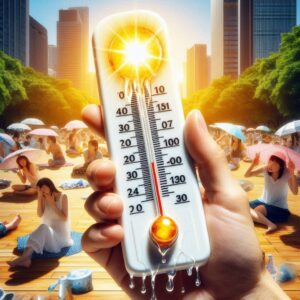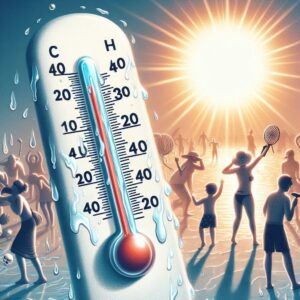災害級の暑さとは?
「災害級の暑さ」という言葉は、近年の異常気象の影響で注目されるようになった表現で、単なる暑さのレベルを超え、人の命や健康に重大な影響を及ぼしかねない危険な高温を指します。気象庁や報道機関がこの表現を使う場合、気温が35度を超える猛暑日や、湿度との相乗効果によって熱中症リスクが極めて高まるような状況を意味します。単なる体感の問題ではなく、実際に人命や社会インフラに被害が出ることがあるため、「災害級」という強い言葉が使われるのです。
言葉の背景と広がり
この表現が注目されるようになったのは、気象庁が2018年に「命に危険が及ぶ暑さ」として、熱中症への厳重な警戒を呼びかける際に使い始めたことがきっかけです。それ以降、毎年のように記録的な猛暑が続き、全国各地で熱中症による搬送者や死亡者が相次いだこともあり、報道機関や行政の発表でも「災害級の暑さ」が定着していきました。やがてSNSや日常会話にも浸透し、2020年代には夏になると多くの人が「今年も災害級の暑さだ」と口にするようになり、流行語の一つとして認知されるようになったのです。
実際の被害と社会への影響
災害級の暑さは、単なる生活の不快感にとどまらず、社会活動全体に深刻な影響を及ぼします。特に高齢者や子ども、持病を持つ人々は熱中症のリスクが高く、毎年数百人単位で命を落とすケースが報告されています。また、外で働く建設業や農業従事者、スポーツを行う学生などにも大きな負担がかかります。学校や企業では熱中症対策のために活動時間を制限したり、冷房の整備を急いだりするなどの対応が必要になってきています。さらに、電力使用量の急増によって電力供給がひっ迫するなど、社会インフラにも影響が及ぶ点が深刻です。
地球温暖化との関連性
災害級の暑さの頻発は、地球温暖化と無関係ではありません。IPCC(気候変動に関する政府間パネル)などの国際的な研究機関は、温室効果ガスの増加によって世界の平均気温が上昇し、それに伴って極端な気象現象が増えると警告しています。日本も例外ではなく、かつては数年に一度だった猛暑日が、今では毎年のように観測され、都市部ではヒートアイランド現象と相まってより深刻な暑さとなっています。災害級の暑さという言葉が定着すること自体が、気候危機の現実を物語っているとも言えるでしょう。
今後の課題と対策
このような極端な高温が日常化している今、私たちが取るべき対策は多岐にわたります。まずは個人レベルでの暑さ対策として、適切な水分補給、冷房の活用、外出の自粛などが求められます。また、自治体や企業による冷却スポットの提供、気温上昇時のアラートシステムの整備、学校や職場での柔軟な運営体制も重要です。さらに、長期的には再生可能エネルギーの推進や都市緑化、建築物の断熱性向上など、地球温暖化対策に本格的に取り組む必要があります。災害級の暑さが一過性の現象ではなくなっている以上、私たちの意識と行動も「災害に備える」姿勢で臨むことが求められているのです。
The term “disaster-grade heat” is an expression that has gained attention in recent years due to extreme weather conditions. It refers to dangerously high temperatures that go beyond the level of mere heat and can have serious effects on human life and health. When used by the Japan Meteorological Agency and news organizations, this expression refers to extremely hot days with temperatures exceeding 35°C (95°F) or situations where the risk of heat stroke is extremely high due to the synergistic effect of humidity. The strong term “disaster-level” is used because it is not merely a matter of physical sensation, but can actually cause damage to human lives and social infrastructure.
Background and Spread of the Term
The expression first came to attention when the Japan Meteorological Agency began using it in 2018 to call for severe warnings against heat stroke as “life-threatening heat. Since then, record-breaking heat waves have continued every year, with a string of people transported or killed by heat stroke across the country, and “disaster-grade heat” has become a common phrase in press and administrative announcements. Eventually, the phrase became a part of social networking and daily conversation, and by the 2020s, many people began to say “It’s another disaster-level heat wave this year” in the summer, and the phrase became recognized as one of the buzzwords of the year.Actual Damage and Social Impact
Disaster-grade heat is more than just a discomfort in daily life; it has a serious impact on all social activities. The elderly, children, and people with chronic illnesses are especially at risk of heat stroke, with hundreds of deaths reported each year. It also takes a heavy toll on construction and agricultural workers who work outside, as well as students who play sports. Schools and businesses are having to limit the hours of activities and hasten the maintenance of air conditioning systems in order to prevent heat stroke. In addition, the impact on social infrastructure is serious, as a sharp increase in electricity use will put a strain on the power supply.Relationship to Global Warming
The frequent occurrence of disaster-level heat is not unrelated to global warming, as the Intergovernmental Panel on Climate Change (IPCC) and other international research organizations have warned that increasing greenhouse gas emissions will cause global average temperatures to rise, which will in turn increase extreme weather events. Japan is no exception. Extreme heat days, which used to occur only once every few years, are now observed every year, and in urban areas, combined with the heat island effect, the heat is becoming more severe. The fact that the term “disaster-grade heat” has taken root in Japan is itself a testament to the reality of the climate crisis.Future Challenges and Countermeasures
Now that extreme high temperatures have become commonplace, there are a wide range of measures that we should take. First of all, as countermeasures against heat at the individual level, we are required to drink appropriate amounts of water, use air conditioning, and refrain from going outside. Also important are the provision of cooling spots by local governments and businesses, the development of alert systems for rising temperatures, and flexible management systems at schools and workplaces. Furthermore, in the long term, full-scale efforts must be made to combat global warming, including the promotion of renewable energy, urban greening, and the improvement of building insulation. As disaster-grade heat is no longer a transient phenomenon, our awareness and actions must also take a “disaster preparedness” stance.
AIが描いた「災害級の暑さ」









コメント